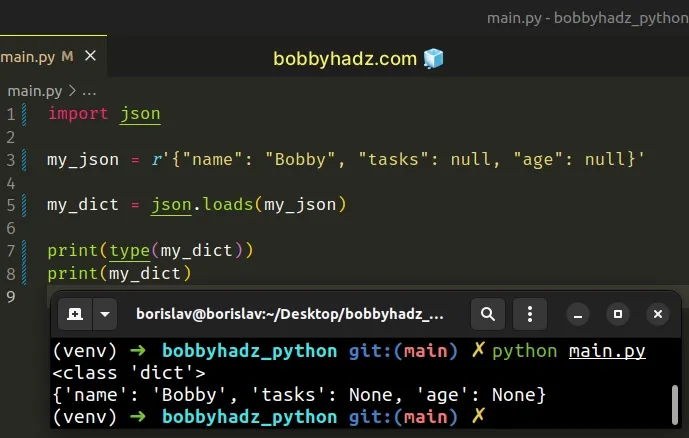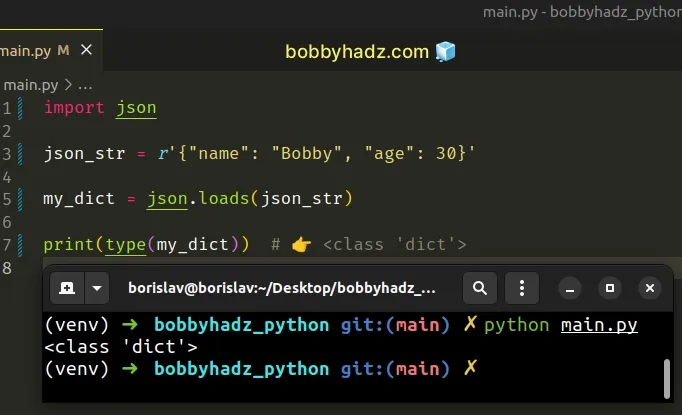How to Convert JSON NULL values to None using Python
Last updated: Apr 8, 2024
Reading time·2 min

# Convert JSON NULL values to None using Python
Use the json.loads() method to convert JSON NULL values to None in Python.
The json.loads method parses a JSON string into a native Python object.
Conversely, the json.dumps method converts a Python object to a JSON
formatted string.
import json my_json = r'{"name": "Bobby", "tasks": null, "age": null}' my_dict = json.loads(my_json) print(type(my_dict)) # 👉️ <class 'dict'> print(my_dict) # 👉️ {'name': 'Bobby', 'tasks': None, 'age': None}

The example shows how to convert null values to None using the json.loads()
method.
# Convert JSON NULL values to Python None values
The json.loads() method parses a JSON string into a native Python object.
import json json_str = r'{"name": "Bobby", "age": 30}' my_dict = json.loads(json_str) print(type(my_dict)) # 👉️ <class 'dict'>

The process of converting a JSON string to a native Python object is called deserialization.
# Convert Python None values to JSON NULL values
You can use the json.dumps() method to convert a Python object to a JSON formatted string.
import json my_json = r'{"name": "Bobby", "tasks": null, "age": null}' # ✅ Convert NULL values to None (JSON string to Python object) my_dict = json.loads(my_json) print(type(my_dict)) # 👉️ <class 'dict'> print(my_dict) # 👉️ {'name': 'Bobby', 'tasks': None, 'age': None} # ✅ Convert None to null (Python object to JSON string) my_json_again = json.dumps(my_dict) print(my_json_again) # 👉️ '{"name": "Bobby", "tasks": null, "age": null}'

The process of converting a native Python object to a JSON string is called serialization.
You can also have None keys in Python objects, but it should generally be
avoided.
import json my_dict = {'name': 'Bobby', None: None} print(my_dict) # 👉️ {'name': 'Bobby', None: None} my_json = json.dumps(my_dict) print(my_json) # 👉️ '{"name": "Bobby", "null": null}' my_dict_again = json.loads(my_json) print(my_dict_again) # 👉️ {'name': 'Bobby', 'null': None}
We started with a Python object that has a None key and a None value.
When we converted the object to JSON, both the key and the value were converted
to null.
When we parsed the JSON string into a Python object, the value was converted to
None, but the key is still the string null.
string. If we pass a key of any other type to the json.dumps() method, the key automatically gets converted to a string.Once the key is converted to a string, parsing the JSON string will return a string key in the Python object.
# Additional Resources
You can learn more about the related topics by checking out the following tutorials:
- How to convert a Tuple to JSON in Python
- How to Delete a JSON object from a List in Python
- How to filter a JSON array in Python
- JSONDecodeError: Expecting value: line 1 column 1 (char 0)
- ValueError: malformed node or string in Python [Solved]
- How to merge multiple JSON files in Python [3 Ways]
- ValueError: Circular reference detected in Python [Solved]
- Process finished with exit code 139 (interrupted by signal 11: SIGSEGV)

